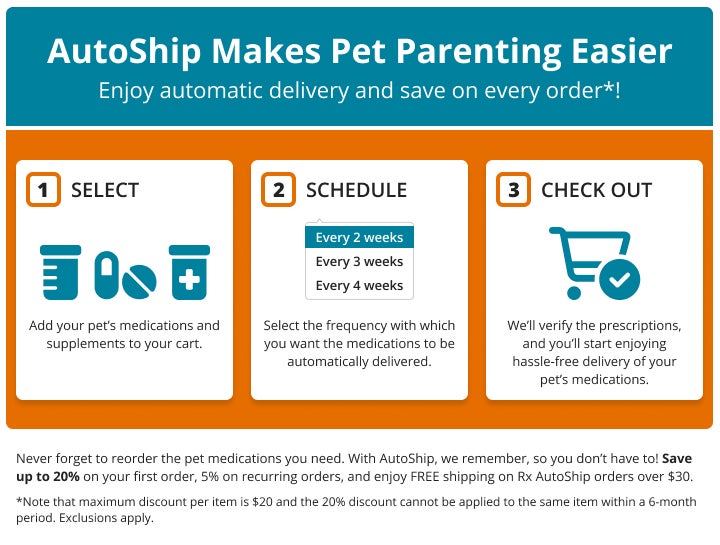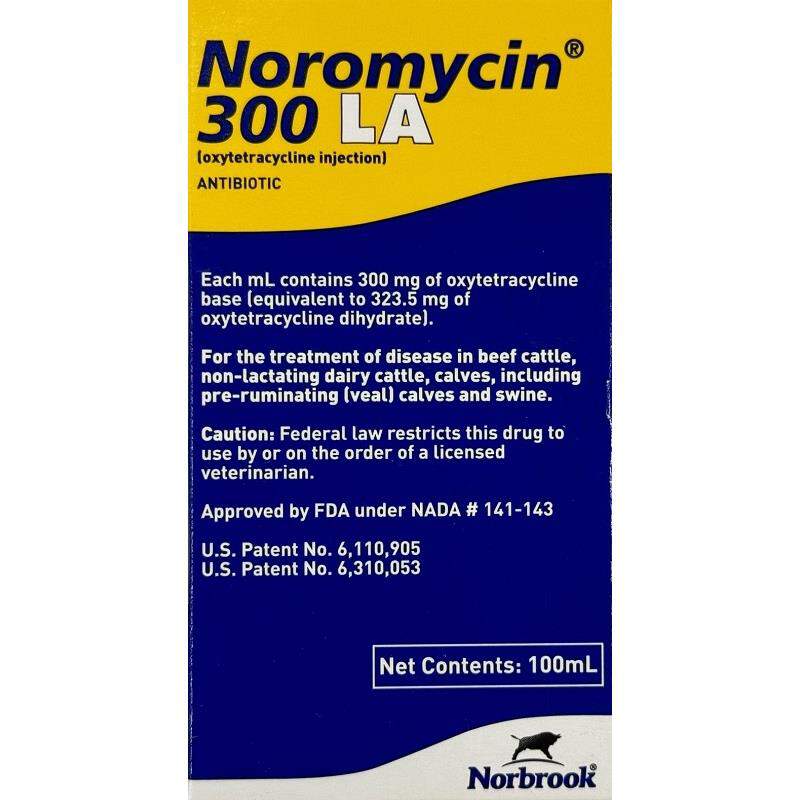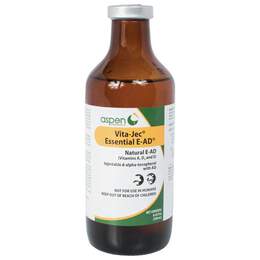

1 of 1
Click on image to open expanded view
Item No.
52792
Noromycin 300 LA (Oxytetracycline) Injectable Rx
Size:
AutoShip & Save 20%
- Save on your Autoship
- Hassle-free: Easily Skip or Change Shipment Dates.
- Commitment-free: Cancel anytime
- Free Shipping.
With AutoShip, we remember so you don’t have to! Learn more
California Residents: Prop. 65 Warning
This product may contain chemicals known to the State of California to cause cancer, birth defects, or other reproductive harm. For more information, go to www.P65Warnings.ca.gov
Noromycin 300 LA (Oxytetracycline) Injectable Description
Noromycin 300 LA Injectable uses oxytetracycline, which is a broad-spectrum, highly versatile, and economical prescription antibiotic. It treats many different conditions in swine and cattle, including:
*This product cannot be shipped to CA.
- Scours associated with Escherichia coli
- Acute metritis associated with strains of streptococcal or staphylococcal organisms
- Leptospirosis
- Wooden tongue
- Foot rot
- Wounds
- Pink eye
- Shipping fever
- Pneumonia
*This product cannot be shipped to CA.
What is Noromycin 300 LA (Oxytetracycline) Injectable
Noromycin 300 LA (Oxytetracycline) Injectable is a versatile, broad-spectrum antibiotic that is useful for treating many conditions in cattle and swine such as : pneumonia, shipping fever, pink eye, wounds, foot rot, wooden tongue, leptospirosis, acute metritis caused by strains of staphylococcal / streptococcal organisms and scours caused by E. coli.
Which animals/pets is Noromycin 300 LA (Oxytetracycline) Injectable for?
For use in swine, dairy cattle, and beef cattle.
Noromycin 300 LA (Oxytetracycline) Injectable uses
Features of Noromycin 300 LA Injectable:
- Economical
- Formula is well-tolerated, especially when it is subcutaneously administered in the neck region
- Proven to be effective against a vast range of diseases, working to treat Escherichia coli-related scours, acute metritis, leptospirosis, wooden tongue, foot rot, wounds, pink eye, shipping fever, and pneumonia
What does Noromycin 300 LA (Oxytetracycline) Injectable do?
Noromycin 300 LA contains oxytetracycline. This ingredient interferes with bacteria's ability to produce protein. When these essential proteins are not present, bacteria can no longer grow or reproduce. Therefore, oxytetracycline effectively stops the infection in its tracks. Any remaining bacteria will die, or the animal's immune system will kill them.
Noromycin 300 LA (Oxytetracycline) Injectable side effects
The following side effects have been observed:
- Possible death
- Collapse
- Labored breathing and other respiratory abnormalities
- Trembling
- Ataxia
- Restlessness
- Swelling at the injection site
Noromycin 300 LA (Oxytetracycline) Injectable ingredients
Oxytetracycline 300 mg/ml
Noromycin 300 LA (Oxytetracycline) Injectable overdose: What to do?
Contact you nearest emergency pet hospital
What to know before using Noromycin 300 LA (Oxytetracycline) Injectable
- Because bacteriostatic medications can interfere with penicillin's bactericidal action, do not give Noromycin 300 LA to any animal being treated with penicillin.
- In case of a superinfection, withdraw treatment and seek proper treatment.
- Any antibiotic, including this medication, can cause non-susceptible fungi or organism overgrowth. If new symptoms or signs develop or if the desired response is not achieved with treatment, this overgrowth may be the cause.
- Immediately following injection, a treated animal may experience short-term hemoglobinuria and associated dark urine.
- If any signs of an adverse reaction are observed, withdraw use and seek veterinary attention. Certain reactions may be caused by allergic reactions (anaphylaxis) or cardiovascular collapse with unknown causes. Speak to your veterinarian before starting treatment to determine the correct treatment to administer in case an adverse reaction occurs.
- Exceeding a volume of 10mL in a subcutaneous or intramuscular injection of adult dairy or beef cattle, administering more than the prescribed number of treatments, exceeding the maximum recommended dose (based on pounds per day), or exceeding 5mL in an intramuscular injection of adult swine can lead to antibiotic residue in periods greater than the typical withdrawal periods.
- Oxytetracycline must be slowly administered intravenously over a minimum five-minute period.
- Administering rapidly (intravenously) can cause the animal to collapse.
- Do not use in a lactating dairy animal.
- Withdraw use a minimum of 28 days before swine or cattle slaughter.
- Do not use in humans. Only for use in livestock.
- Follow the withdrawal periods specified on the product label.
How is Noromycin 300 LA (Oxytetracycline) Injectable sold?
100 ml, 250 ml and 500 ml vials
Manufacturer
Norbrook Labs
Overview
Use as directed by your Veterinarian.
Dosage and Administration :
Beef cattle, non-lactating dairy cattle, calves, including pre-ruminating (veal) calves:
A single dosage of 9 mg of oxytetracycline per pound of bodyweight administered intramuscularly or subcutaneously is recommended in the treatment of the following conditions:
(1) Bacterial pneumonia caused by Pasteurella spp (shipping fever) in calves and yearlings where retreatment is impractical due to husbandry conditions, such as cattle on range, or where their repeated restraint is inadvisable.
(2) Infectious bovine keratoconjunctivitis (pink eye) caused by Moraxella bovis.
For other indications NOROMYCIN 300 LA is to be administered intramuscularly, subcutaneously or intravenously at a level of 3 to 5 mg of oxytetracycline per pound of bodyweight per day. In treatment of foot-rot and advanced cases of other indicated diseases, a dosage level of 5 mg per pound of bodyweight per day is recommended. Treatment should be continued 24 to 48 hours following remission of disease signs, however, not to exceed a total of four (4) consecutive days. If improvement is not noted within 24 to 48 hours of the beginning of treatment, diagnosis and therapy should be re-evaluated by a veterinarian.
Do not administer intramuscularly in the neck of small calves due to lack of sufficient muscle mass.
Use extreme care when administering this product by intravenous injection. Perivascular injection or leakage from an intravenous injection may cause severe swelling at the injection site.
Swine:
A single dosage of 9 mg of oxytetracycline per pound of bodyweight administered intramuscularly is recommended in the treatment of bacterial pneumonia caused by Pasteurella multocida in swine, where retreatment is impractical due to husbandry conditions or where repeated restraint is inadvisable.
NOROMYCIN 300 LA can also be administered by intramuscular injection at a level of 3 to 5 mg of oxytetracycline per pound of bodyweight per day. Treatment should be continued 24 to 48 hours following remission of disease signs; however, not to exceed a total of four (4) consecutive days. If improvement is not noted within 24 to 48 hours of the beginning of treatment, diagnosis and therapy should be re-evaluated by a veterinarian.
For sows, administer once intramuscularly 3 mg of oxytetracycline per pound of bodyweight approximately eight (8) hours before farrowing or immediately after completion of farrowing as an aid in the control of infectious enteritis in baby pigs.
For swine weighing 25 lbs of bodyweight and under, NOROMYCIN 300 LA should be administered undiluted for treatment at 9 mg/lb but should be administered diluted for treatment at 3 or 5 mg/lb.
Directions For Use :
NOROMYCIN 300 LA is intended for use in the treatment of disease due to oxytetracycline-susceptible organisms in beef cattle, non-lactating dairy cattle and swine. A thoroughly cleaned, sterile needle and syringe should be used for each injection (needles and syringes may be sterilised by boiling in water for 15 minutes). In cold weather NOROMYCIN 300 LA should be warmed to room temperature before administration to animals. Before withdrawing the solution from the bottle, disinfect the rubber cap on the bottle with suitable disinfectant, such as 70 percent alcohol. The injection site should be similarly cleaned with the disinfectant. Needles of 16 to 18 gauge and 1 to 1 1/2 inches long are adequate for intramuscular or subcutaneous injections. Needles of 2 to 3 inches in length are recommended for intravenous use.
INTRAMUSCULAR ADMINISTRATION:
Intramuscular injections should be made by directing the needle of suitable gauge and length into the fleshy part of a thick muscle such as in the neck, rump, hip, or thigh regions; avoid blood vessels and major nerves. Before injecting the solution, pull back gently on the plunger. If blood appears in the syringe, a blood vessel has been entered; withdraw the needle and select a different site.
No more than 10 mL should be injected intramuscularly at any one site in adult beef cattle and non-lactating dairy cattle, and not more than 5 mL per site in adult swine; rotate injection sites for each succeeding treatment. The volume administered per injection site should be reduced according to age and body size so that 1 to 2 mL per site is injected in small calves.
SUBCUTANEOUS ADMINISTRATION:
Subcutaneous injections should be made by directing the needle of suitable gauge and length through the loose folds of the neck skin in front of the shoulder. Care should be taken to ensure that the tip of the needle has penetrated the skin but is not lodged in the muscle. Before injecting the solution, pull back gently on the plunger. If blood appears in the syringe, a blood vessel has been entered; withdraw the needle and select a different site. The solution should be injected slowly into the area between the skin and muscles. No more than 10 mL should be injected subcutaneously at any one site in adult beef cattle and non-lactating dairy cattle; rotate injection sites for each succeeding treatment. The volume administered per injection site should be reduced according to age and body size so that 1 to 2 mL per site is injected in small calves.
Intravenous Administration
NOROMYCIN 300 LA may be administered intravenously to beef cattle and non-lactating dairy cattle. As with all highly concentrated materials, NOROMYCIN 300 LA should be administered slowly by the intravenous route.
Preparation of the Animal for Injection:
1. Approximate the location of a vein. The jugular vein runs in the jugular groove on each side of the neck from the angle of the jaw to just above the brisket and slightly above and to the side of the windpipe (See Fig. 1).
2. Restraint. A stanchion or chute is ideal for restraining the animal. With a halter, rope, or cattle leader (nose tongs), pull the animal’s head around the side of the stanchion, cattle chute, or post in such a manner to form a bow in the neck (See Fig. 2), then snub the head securely to prevent movement. By forming the bow in the neck, the outside curvature of the bow tends to expose the jugular vein and make it easily accessible. Caution: Avoid restraining the animal with a tight rope or halter around the throat or upper neck which might impede blood flow. Animals that are down present no problem so far as restraint is concerned.
3. Clip hair in area where injection is to be made (over the vein in the upper third of the neck). Clean and disinfect the skin with alcohol or other suitable antiseptic.
Entering the Vein and Making the Injection:
1. Raise the vein. This is accomplished by tying the choke rope tightly around the neck close to the shoulder. The rope should be tied in such a way that it will not come loose and so that it can be untied quickly by pulling the loose end (See Fig. 2). In thick-necked animals, a block of wood placed in the jugular groove between the rope and the hide will help considerably in applying the desired pressure at the right point. The vein is a soft flexible tube through which blood flows back to the heart. Under ordinary conditions it cannot be seen or felt with the fingers. When the flow of blood is blocked at the base of the neck by the choke rope, the vein becomes enlarged and rigid because of the back pressure. If the choke rope is sufficiently tight, the vein stands out and can be easily seen and felt in thin-necked animals. As a further check in identifying the vein, tap it with the fingers in front of the choke rope. Pulsations that can be seen or felt with the fingers in front of the point being tapped will confirm the fact that the vein is properly distended. It is impossible to put the needle into the vein unless it is distended. Experienced operators are able to raise the vein simply by hand pressure, but the use of a choke rope is more certain.
2. Inserting the needle. This involves three distinct steps. First, insert the needle through the hide. Second, insert the needle into the vein. This may require two or three attempts before the vein is entered. The vein has a tendency to roll away from the point of the needle, especially if the needle is not sharp. The vein can be steadied with the thumb and finger of one hand. With the other hand the needle point is placed directly over the vein, slanting it so that its direction is along the length of the vein, either toward the head or toward the heart. Properly positioned this way, a quick thrust of the needle will be followed by a spurt of blood through the needle, which indicates that the vein has been entered. Third, once in the vein, the needle should be inserted along the length of the vein all the way to the hub, exercising caution to see that the needle does not penetrate the opposite side of the vein. Continuous steady flow of blood through the needle indicates that the needle is still in the vein. If blood does not flow continuously, the needle is out of the vein (or clogged) and another attempt must be made. If difficulty is encountered, it may be advisable to use the vein on the other side of the neck.
3. While the needle is being placed in proper position in the vein, an assistant should get the medication ready so that the injection can be started without delay after the vein has been entered.
4. Making the injection. With the needle in position as indicated by continuous flow of blood, release the choke rope by a quick pull on the free end. This is essential - the medication cannot flow into the vein while it is blocked. Immediately connect the syringe containing OXYTETRACYCLINE to the needle and slowly depress the plunger. If there is resistance to depression of the plunger, this indicates that the needle has slipped out of the vein (or is clogged) and the procedure will have to be repeated. Watch for any swelling under the skin near the needle, which would indicate that the medication is not going into the vein. Should this occur, it is best to try the vein on the opposite side of the neck.
5. Removing the needle. When injection is complete, remove needle with straight pull. Then apply pressure over area of injection momentarily to control any bleeding through needle puncture, using cotton soaked in alcohol or other suitable antiseptic.
Main Ingredients
Oxytetracycline 300 mg/ml






